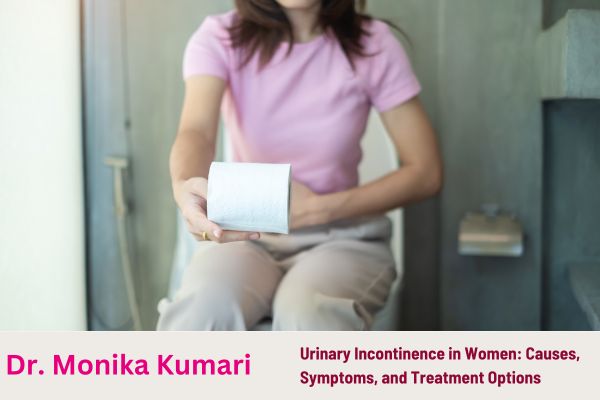Uterine Fibroids: Causes, Symptoms, and Treatment Options with Dr. Monika Kumari
Uterine fibroids are non-cancerous growths that develop in the uterus, affecting many women during their reproductive years. Dr. Monika Kumari, a leading expert in gynecology, sheds light on the causes, symptoms, and available treatments for this common condition. Understanding uterine fibroids is essential for managing them effectively and maintaining overall reproductive health.
What Are Uterine Fibroids?
Uterine fibroids, also known as myomas or leiomyomas, are benign (non-cancerous) tumors that grow in or on the uterus. These growths vary in size, with some being small and asymptomatic, while others can cause significant pain and discomfort. Uterine fibroids can develop in different locations within the uterus, such as the inner lining (submucosal), the muscle wall (intramural), or on the outer surface (subserosal).
Causes of Uterine Fibroids
While the exact cause of uterine fibroids remains unclear, several factors have been identified as contributors:
- Hormonal Factors: Estrogen and progesterone, the hormones responsible for the growth of the uterine lining during pregnancy, also stimulate the growth of fibroids. This explains why fibroids often grow larger during pregnancy and shrink after menopause.
- Genetics: Family history plays a significant role in the development of fibroids. Women with a family history of fibroids are more likely to develop them themselves.
- Age and Race: Women in their 30s and 40s are more likely to develop uterine fibroids. Additionally, African American women tend to experience more severe fibroid symptoms and at a younger age.
- Lifestyle Factors: Obesity, high blood pressure, and an unhealthy diet rich in red meat and low in fruits and vegetables have been linked to an increased risk of developing uterine fibroids.
Symptoms of Uterine Fibroids
Many women with uterine fibroids do not experience symptoms, and they may only discover the condition during a routine checkup. However, some common symptoms include:
- Heavy Menstrual Bleeding: One of the most common symptoms of uterine fibroids is abnormally heavy or prolonged menstrual bleeding, which can lead to anemia and fatigue.
- Pelvic Pain and Pressure: Larger fibroids may cause a feeling of heaviness, bloating, or pain in the pelvic area, particularly during physical activity or sexual intercourse.
- Frequent Urination: Fibroids pressing on the bladder can cause frequent urination or difficulty emptying the bladder completely.
- Pain During Sex: Women with fibroids may experience discomfort or pain during sexual intercourse.
- Infertility: In rare cases, fibroids may interfere with conception or cause pregnancy complications such as miscarriage or preterm labor.
Treatment Options for Uterine Fibroids
Treatment for uterine fibroids depends on factors such as the size, location, and symptoms of the fibroids, as well as the woman’s age and desire for fertility. Dr. Monika Kumari emphasizes that a personalized approach to treatment is essential to effectively manage fibroids.
- Medications:
- Hormonal Therapy: Birth control pills or hormone-releasing devices (IUDs) can help control heavy bleeding and pelvic pain caused by fibroids.
- GnRH Agonists: These drugs lower estrogen levels and shrink fibroids. However, they are typically used temporarily due to their side effects.
- Nonsteroidal Anti-Inflammatory Drugs (NSAIDs): Pain-relief medications such as ibuprofen can alleviate mild pain and cramps associated with fibroids.
- Minimally Invasive Procedures:
- Uterine Artery Embolization (UAE): This procedure blocks the blood supply to the fibroids, causing them to shrink.
- Laparoscopic or Robotic Myomectomy: A minimally invasive surgery that removes fibroids while preserving the uterus, an option for women who wish to maintain their fertility.
- Endometrial Ablation: A procedure that removes or destroys the uterine lining, reducing heavy bleeding caused by fibroids.
- Surgical Options:
- Myomectomy: A surgical procedure to remove fibroids while preserving the uterus. This option is ideal for women who want to maintain their fertility.
- Hysterectomy: In severe cases, a hysterectomy (removal of the uterus) may be recommended, particularly if other treatments have been ineffective. This is the most definitive treatment for fibroids but eliminates fertility.
- Lifestyle Modifications:
- Healthy Diet and Exercise: Maintaining a healthy weight and consuming a balanced diet rich in fruits, vegetables, and fiber may help manage fibroid symptoms and reduce the risk of further growth.
When to Consult a Doctor
If you experience any of the following symptoms, it’s important to consult a gynecologist like Dr. Monika Kumari for a proper diagnosis:
- Heavy or prolonged menstrual bleeding
- Pelvic pain or pressure
- Pain during sex
- Difficulty urinating or frequent urination
- Infertility or pregnancy complications
A gynecologist will conduct an examination, and additional imaging tests such as ultrasound or MRI may be recommended to determine the size, location, and number of fibroids.
Conclusion
Uterine fibroids are a common condition that can have a significant impact on a woman’s quality of life. While many women may not experience symptoms, others may struggle with heavy bleeding, pelvic pain, and fertility issues. Thankfully, various treatment options are available, from medications to minimally invasive procedures and surgery. Dr. Monika Kumari emphasizes that early detection and personalized treatment are key to effectively managing fibroids and improving women’s health and well-being.

